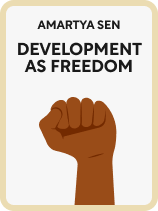

This article is an excerpt from the Shortform book guide to "Development as Freedom" by Amartya Sen. Shortform has the world's best summaries and analyses of books you should be reading.
Like this article? Sign up for a free trial here .
What happens to the economy when women have fewer rights than men? What’s the best way to fix the gender bias against women?
Amartya Sen in Development as Freedom states that misogyny is preventing developing countries from flourishing. Depriving women of basic rights has proven to increase crime rates and reduce female life expectancy, which means that fewer people can contribute to the economy.
Learn more about the economic impact of gender inequality and how to put a stop to it.
Women and Economic Development
Sen identifies bias against women as a major obstacle to growth in developing countries. This bias deprives women of basic rights in areas such as political participation and family planning. There’s also a major economic impact of gender inequality. It harms economic development by failing to tap into the productive capacity of women by excluding them from education and the workforce. By empowering women, Sen argues, not only are women better off, but their communities become safer and more prosperous.
The Phenomenon of “Missing Women”
Sen notes that bias against women has resulted in a troubling trend that highlights the harms of misogyny on public health and development. One manifestation of this bias is the phenomenon of “missing women” in developing countries.
In most of the Western world, South America, and Sub-Saharan Africa, there are slightly more women than men. This is due to factors such as:
- Women are “hardier” than men, meaning they survive better given equivalent treatment and have naturally longer life expectancies.
- Most war casualties are men.
- Men, on average, engage in riskier behavior than women.
- Men are disproportionately the victims of violent crimes.
However, in some parts of the world, such as China, India, and parts of the Middle East and North Africa, there are more men than women. Considering that the factors above apply to these places as well, this finding needs explaining.
Sen’s research suggests the explanation is anti-female bias. In these regions, girls are neglected more than boys, especially in early childhood. This neglect comes in the areas of health care, with many poor families choosing to invest more in boys, whom they consider more “valuable.” This leads to more girls suffering from malnourishment and other health problems that reduce life expectancies.
Anti-female bias also comes in the form of sex-selective abortion. In China, the government implemented a “one-child policy” around 1979 in an attempt to combat overpopulation. (Shortform note: China has since adopted a “two-child policy.”) These forces have led some nations to have populations with approximately 0.05-0.10% fewer females than males.
This may seem like a small difference. However, it amounts to around 60 million to 100 million fewer women, as a result of social bias. The economic impact of gender inequality is clearly present when there are fewer women to contribute to the economy and worse health for children.
Effect of Missing Women on Crime Rates
While Sen addresses the moral implications of “missing women,” researchers have discovered that China’s one-child policy may also be contributing to the nation’s six-fold increase in crime.
Young unmarried men commit more than two-thirds of violent and property crime in China. There are currently around 120 men for every 100 women in China. This makes it difficult for many men to find a wife. Researchers found that this skewed male-to-female ratio accounts for a 34% increase in violence.
Given the relative scarcity of Chinese women, it has also become customary for men to provide a sizable cash offering to the bride’s family, which researchers believe has encouraged men to commit more financial crimes.
Additionally, research indicates that when boys grow up in male-heavy environments, they have a greater propensity to commit acts of violence. This impact on crime rates is one more effect of the phenomenon of “missing women” that Sen helped identify through his research.
Reducing the Economic Impact of Gender Inequality
Sen says the fix to gender bias is to improve women’s agency.
When women are free to choose whether to pursue an education, enter the workforce, or have children, they usually make choices that benefit not only themselves, but their families and communities. This is because they are better equipped than the government to understand the implications of these choices on the people around them. When afforded the same opportunities as men, Sen contends that women become agents of change who can transform communities and societies for the better.
Women’s Empowerment and Child Welfare
Sen argues that the most effective way to reduce gender inequality’s economic impact is to increase literacy. Research shows that increases in female literacy are strongly associated with a reduction in child mortality. This is because the knowledge women gain through education allows them to better care for their children.
In addition to reducing overall child mortality, female literacy (and female labor force participation) is also associated with closing the gap in mortality rates between boys and girls.
Other factors, such as male literacy and urbanization, weren’t associated with such reductions. This dynamic highlights Sen’s point that traditional methods of development don’t always lead to the desired results.
In this case, overall economic development was not enough to reduce child mortality, but women’s literacy was. For example, one study in India showed that a 50% reduction in the overall poverty rate made almost no difference in under-5 child mortality rates, but an increase in female literacy from 22% to 75% reduced child mortality rates from 156 per thousand births to 110 per thousand births.
Women’s Empowerment and Fertility Rates
The benefits of female literacy and labor force participation have a similar positive effect on fertility rates. Around the globe, a greater recognition of women’s rights usually leads to a reduction in fertility rates (the average number of children born per woman).
In many developing societies, women have little choice in family planning. Education gives women greater knowledge about family planning, and work outside the home often gives them more options, too.

———End of Preview———
Like what you just read? Read the rest of the world's best book summary and analysis of Amartya Sen's "Development as Freedom" at Shortform .
Here's what you'll find in our full Development as Freedom summary :
- The five types of freedom that are integral to economic development
- How democracy can prevent famine
- How empowering women helps communities






